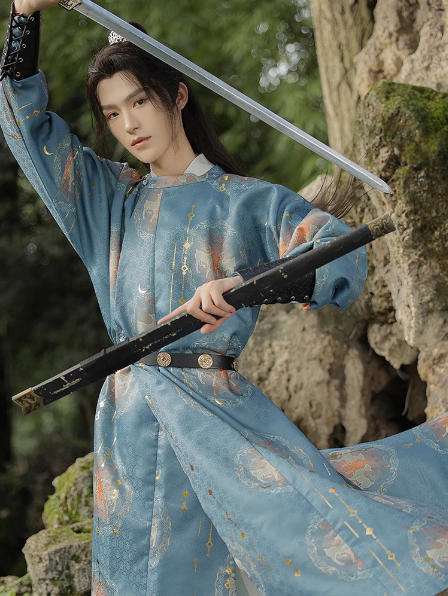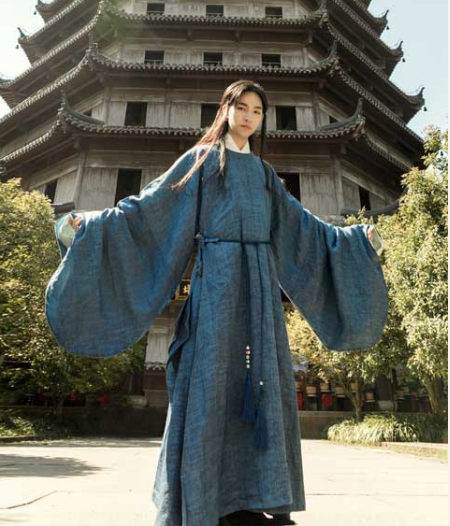In traditional China, men commonly wore Hanfu, Changshan, and Magua, each varying by dynasty and social status.
Historical Evolution of Men Traditional Attire in China
Ancient Dynasties
The journey of traditional Chinese men’s attire begins with the ancient dynasties, where Hanfu reigned supreme. Originally, Hanfu presented a loose, flowing silhouette, characterized by its cross-collar design, wide sleeves, and sash tied around the waist. This attire, often made from silk, was not just a fashion statement but also a symbol of cultural identity. The Han Dynasty saw the refinement of Hanfu, incorporating intricate patterns and vibrant colors, reflecting the wearer’s status and occasion.
Tang Dynasty
Moving into the Tang Dynasty, men’s attire transformed into a reflection of poetic elegance. The Tang period is renowned for its liberal, cosmopolitan nature, which greatly influenced clothing styles. Garments became more elaborate, with wider sleeves and brighter colors. Silk remained a popular fabric, but the introduction of cotton provided more comfort and versatility. The Tang Dynasty’s attire is often celebrated in classical Chinese literature and art, showcasing its significant cultural impact.

Ming and Qing Dynasties
The Ming and Qing Dynasties marked a significant transition in men’s traditional attire. During the Ming era, the style became more subdued, favoring darker colors and simpler designs. The introduction of the Zhiduo, a form of long gown, and the Shenyi, a one-piece garment, became prevalent. The Qing Dynasty introduced the Changshan, a form-fitting, long gown that significantly influenced modern Chinese men’s fashion. This period also saw the Manchu influence, introducing garments like the Magua, a horse-riding jacket, reflecting the merging of cultural attire.
Each epoch in Chinese clothing history not only showcases a change in styles and materials but also mirrors the societal, cultural, and political landscapes of the time. The evolution from loose, flowing Hanfu to the more structured and subdued styles of the Ming and Qing dynasties encapsulates a rich tapestry of Chinese history, imbued in every thread and pattern of traditional men’s attire.
The historical progression of men’s traditional attire in China is a vivid tapestry, intricately woven with cultural, social, and political threads. Each dynasty brought its unique flair and influence, creating a rich legacy that continues to inspire fashion and culture globally. From the silk-laden, vibrant Hanfu of the ancient dynasties to the refined elegance of the Tang, and the structured sophistication of the Ming and Qing, Chinese men’s traditional attire is a story of evolving beauty and enduring heritage.
Components of Traditional Chinese Male Attire
Upper Garments(Shirts and Jackets)
The upper garments in traditional Chinese male attire are both functional and symbolic. Shirts and jackets, often made of silk or cotton, feature intricate designs and fine craftsmanship. The cross-collar shirt, a staple, symbolizes elegance and respect. Jackets vary in style, from the simple Yishang worn by commoners to the more ornate Pifeng, reserved for the elite. These garments showcase not only the wearer’s social status but also the rich textile heritage of China.
Lower Garments(Pants and Skirts)
For lower garments, traditional Chinese male attire predominantly includes pants and skirts. Pants, usually made of cotton or silk, are comfortable and practical for everyday wear. They often feature a loose fit, allowing for ease of movement. Skirts, such as the Chang, are reserved for more formal occasions, symbolizing respect and dignity. These skirts often have detailed embroidery and are paired with a matching upper garment, creating a harmonious and dignified look.
Headwear and Footwear(Hats and Shoes)
Headwear and footwear complete the traditional Chinese male attire. Hats, like the Putou or the Wu Sha Mao, vary in style and significance, often indicating the wearer’s social status or occupation. Shoes are typically made of cloth or leather, with designs ranging from the simple cloth shoe for daily wear to the more elaborate, embroidered shoe for special occasions. These accessories not only serve practical purposes but also add to the aesthetic and cultural significance of the attire.
The traditional Chinese male attire, with its diverse components, reflects a blend of functionality, social symbolism, and cultural heritage. Each element, from the upper garments to the headwear, plays a crucial role in conveying the wearer’s identity and social standing, making the attire a living tapestry of Chinese culture and history.
Cultural Significance and Symbolism
The traditional attire of Chinese men is not just a fashion statement but a rich tapestry of cultural significance and symbolism. Each element, from the fabric to the color, and from the style to the occasion, carries profound meanings and reflects centuries-old traditions.
Color Symbolism in Traditional Wear
Colors in traditional Chinese attire are deeply symbolic. Red, a color of luck and joy, is often worn during festivals and weddings. Black, representing stability and strength, is a common choice for everyday wear. Yellow, historically reserved for the emperor, symbolizes power and royalty. Blue and green, representing spring and growth, are popular choices for everyday attire. Each color choice in traditional wear is not merely a matter of aesthetic preference but a reflection of deeper cultural values and beliefs.
Clothing and Social Status
Clothing in traditional Chinese culture is a clear indicator of social status. The intricate embroidery and quality of fabric in an individual’s attire often signify their social standing. Imperial attire, with its luxurious fabrics and elaborate designs, was exclusive to the royal family and high-ranking officials. Commoners wore simpler, more functional clothing, reflecting their place in society. This distinction in clothing styles serves as a visual representation of the hierarchical nature of ancient Chinese society.
Festivals and Ceremonial Attire
During festivals and ceremonies, traditional Chinese attire takes on an even greater significance. For instance, during the Lunar New Year, men often wear new, brightly colored outfits to symbolize a fresh start and good fortune. Dragon Boat Festival attire might feature designs symbolizing protection and strength. Wedding attire, especially, is chosen with great care, often featuring auspicious symbols to bless the union. This ceremonial attire is not just about looking one’s best; it’s a way to honor traditions and participate in the cultural narrative of the occasion.
The cultural significance and symbolism embedded in traditional Chinese male attire are profound and multi-layered. It’s a visual feast that tells stories of history, society, and beliefs, an intricate dance of colors, fabrics, and styles that continues to captivate and inspire.
Regional Variations in Traditional Attire
The traditional attire of Chinese men exhibits remarkable regional variations, reflecting the diverse climate, culture, and historical influences across different parts of China. From the robust styles of the north to the vibrant attire in the south and the unique influences of ethnic minorities, these variations offer a rich glimpse into China’s sartorial diversity.
Northern China
In the colder climate of Northern China, men’s traditional attire focuses on robustness and functionality. The clothing is typically made from heavier fabrics like wool and thick cotton to provide warmth. Styles like the padded Changshan or the fur-trimmed Yi are common, offering both comfort and protection against the harsh northern winters. These garments are often in darker colors, reflecting the practical needs of daily life in a colder environment.

Southern China
Contrastingly, in Southern China, where the climate is warmer and more humid, traditional male attire features lighter fabrics and brighter colors. Silk, known for its breathability and lightness, is a popular choice. The styles here lean towards looser fits, allowing for better air circulation. Vivid colors and intricate patterns are common, reflecting the region’s lush landscapes and vibrant cultural heritage. Outfits like the thin, light Changshan are popular, providing comfort and style in the southern heat.
Ethnic Minority Influences on Clothing
China’s rich tapestry of ethnic minorities brings a kaleidoscope of influences to traditional male attire. Each minority group, from the Tibetans to the Miao, has distinct clothing styles, often reflecting their unique cultural backgrounds and lifestyles. For instance, Tibetan traditional attire includes heavy, warm robes to suit the high-altitude climate, while the Miao are known for their elaborate silver jewelry and intricate embroidery. These diverse styles contribute to the rich mosaic of Chinese traditional attire, showcasing a country with a profound depth of cultural diversity.
In exploring the regional variations in traditional Chinese male attire, we uncover a narrative that goes beyond mere fashion. It’s a story of adaptation and expression, where each garment reflects the geography, climate, and cultural ethos of its region. This diversity not only adds to the richness of Chinese culture but also offers an intriguing lens through which to view the country’s vast and varied history.